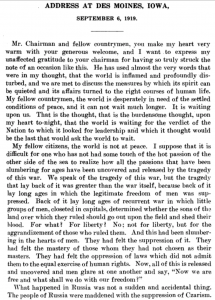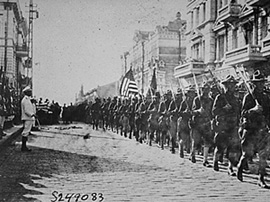Woodrow Wilson, Address at Des Moines, Iowa, 1919

Woodrow Wilson was president at the time the Russian Revolution of 1917 was under full swing. He gave this speech on September 6, 1919 in Des Moines, Iowa at a time when there was a Red Scare raging across the United States. In this speech he warns the Bolsheviks “the poison of disorder, the poison of revolt, the poison of chaos” had spread and that some of that “poison” had gotten in the “veins of the free people”. He had given speeches on the Russian Civil War before, but it was in a more positive tone. In this speech he changes that tone and was portraying how the Bolsheviks got into power as evil. This is a good source for my project because it shows how the United States felt about the Bolsheviks and foreshadows future relations between both countries. This source was found in a book by Woodrow Wilson that included speeches he had given.
American Soldiers Parade in Vladivostok, 1918

President Woodrow Wilson had decided that the United States, still at war in Europe, must intervene in another part of the world to protect its investments. It had nearly a billion dollars’ worth of American guns and military equipment that had been transported in the Trans-Siberian Railway between Vladivostok and Nikolsk. President Woodrow Wilson’s motivation for sending troops to Siberia were due to him wanting to promote democracy and try to convince people that democracy is better than any other type of government. The image above shows soldiers marching through the streets of Vladivostok.
Letter from the Soviet Government to President Woodrow Wilson

The Russia soviet government sent a letter to President Woodrow Wilson on October 24, 1918 calling him out because of the help that the United Stated have provided to counter-revolutionist and anti-Bolsheviks. President Wilson had repeatedly spoken about letting the Russian Revolution run its course without intervening. The Soviet government was not happy that there are Allied and American troops in Russia and helping the counter-revolutionists. In the letter, they mentioned that President Wilson had promised the Russian people to assist them in their struggle for independence. The Soviet government feel that they were betrayed and lied to by president Wilson for going against his promises.
Document of Food Shipments on Russia

After the Bolshevik Revolution of 1917, the ensuing Civil War produced food shortages in southwestern Russia. The Soviets were so desperate that they sent a worldwide request for food aid. In 1921, Herbert Hoover was appointed by president Warren Harding to organize a relief effort. Congress authorized $20 million, and Hoover proceeded to organize the American Relief Administration (ARA) to do the job. Under Hoover’s terms, the ARA was to be a completely American-run relief program for the transport, storage, and delivery of relief supplies (mainly food and seed grain) to those in the famine region. After Soviet officials agreed, hundreds of American volunteers were dispatched to oversee the program. The ARA gradually earned the trust of the local Communist authorities and was able to distribute thousands of tons of grain, as well as clothing and medical supplies. The image above shows a document that is signed by important Soviet officials agreeing to receive aid from the United States. Some of the Soviet officials that signed it include, Josef Stalin, Lenin, and Trotsky. This remarkable humanitarian effort was credited with saving many millions of lives. ARA aid continued into 1923, by which time local farms were again producing and the famine’s grip was broken.
